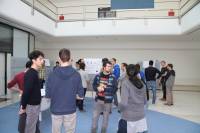User Tools
This is an old revision of the document!
Table of Contents
ICT innovation / Product Design and Development (2014/2015)
This course is offered at the University of Trento by the security group in the framework of the three main Master offered by Trento (Security and Privacy, Internet Technology and Architecture, Service Design and Engineering) within the European Institute of Innovation and Technology (ICT Labs).
See the UNITN S&P EIT page for further information on the Security and Privacy courses.
See the current ICT Innovation Course for further information.
Course Objective
Illustrate (some) steps of product design and developement and guide students, forming multi-disciplinary teams, into the development of a “product” as opposed to just a “project”.
Credits (6-9 ECTS)
This course is normally 6ECTS credits for MSc students enrolled in Trento or for EIT/ICTLabs students joining Trento as exit students. For EIT/ICTLabs master students having Trento as entry students this course will yield 9 credits as it includes the credits for the EIT/ICTLabs summer school.
Course Structure
- Learning: Lectures on Product Design and Development (PD&D)
- Introduction
- Product Specifications
- Concept (Mostly selection and testing)
- Product Architecture
- Prototyping and robust design
- Patents and Intellectual Property
- Thinking: Concept's Idea Canvas (up to 10/30 grade points)
- Each team will produce a concept's idea canvas to clarify the key strong points on their product
- Designing: Product design and architecture (up to 10/30 grade points)
- Teams will produce a poster explaining how their product will work
- Producing: Product prototype (up to 15/30 grade points)
- Each team will have a small budget for hardware/software and will have to actually present a working product
Overarching Learning Objectives
- Creativity: How to solve problems when not all steps are completely specified (this what you should try to do with your design/architectural result)
- Intellectual Transformation: How to transform an idea into a product (the first “brainstorming” step is your research canvas, the last one is the final product)
- Leadership: Organize yourselves into a team and arrive to make a final product (you should try to leverage on each other’s competences)
- Making value judgement: Decide which parts are important and which are not (this should be an important part of the process that produce a lean design, as you have no time to make a sophisticated one with parts that you don’t need)
Lecturer
Prof. Fabio Massacci
Teaching Assistants: Anteneh Atumo (Internet Technologies and Architectures), Bernardo Villalba Frías (Embedded Systems), Luca Allodi (Security and Privacy), Stefano Tranquillini (Service Design and Engineering)
Textbook
Karl T. Ulrich and Steven D. Eppinger. Product Design and Development. 5th edition, Irwin McGraw-Hill, 2012.
There is also an eBook with a subset of the chapters that is used as a textbook for Karl Ulrich's Product Design on-line Course on Coursera for 30$. You can go to McGraw-Hill on-line shop and then search for Karl Ulrich or ISBN:9781308099064.
Spring 2015
Product's Idea
The following idea for the product by Samy Kamkar has been selected for the 2015 course.
“KeySweeper is a stealthy Arduino-based device, camouflaged as a functioning USB wall charger, that wirelessly and passively sniffs, decrypts, logs and reports back (over GSM) all keystrokes from any Microsoft wireless keyboard in the vicinity. All keystrokes are logged online and locally. SMS alerts are sent upon trigger words, usernames or URLs, exposing passwords. KeySweeper continues to operate using its internal battery. A web based tool allows live keystroke monitoring.”
More details on the idea are available on Samy Kamkar's webpage. Read them.
Schedule
- Monday - room A220 - 9:30-11:00
- Friday - room A220 - 9:30-12:00 (up to 13:00 on the ShowRoom days)
| Date | Topic | Slides | Other Material |
|---|---|---|---|
| 2015-02-18 | Administrative Information | Lecture 00 | Group Division |
| 2015-02-20 | Introduction | Introduction | |
| 2015-02-25 | Concept Design | Customer Needs and Product Specs | |
| 2015-02-27 | Concept Selection and Testing | Concept Selection and Testing | |
| 20015-03-4,6 | No lectures | Prepare Concept's Idea Canvas tn_-_04_-_concept_canvas.pptx | For a similar idea look at this video from iMinds https://www.youtube.com/watch?v=Cq7NmKmwplw |
| 2015-03-11 | IPR (Patents, etc.) | Intellectual Property | SEC Filings in 2014 by Google and Pfizer. Example patents on Browser's bookmarks and a Coffee Cup Sleeve |
| 2015-03-13 | Concept's idea canvas show at CLC |  | The two best teams are Key-9  , with the most focussed and low-cost product, and Sniffpy , with the most focussed and low-cost product, and Sniffpy  with the most integrated engineered product. with the most integrated engineered product. |
| 2015-03-16 | No lectures | Prepare Design | |
| 2015-03-20 | Feedback session | Book your group on doodle | |
| 2015-03-23 | No Lecture | Prepare list of components | Provide to Alessandro Tomasi the list of needed hardware and software components |
| 2015-03-27 | Digital Forensic | Lecture by A. Barili, Court's expert for the Garlasco Murder | |
| 2015-03-30 | Product Architecture | Slides | |
| 2015-04-3,6 | Eastern Holidays | ||
| 2015-04-10 | No lecture (upon students' request) | ||
| 2015-04-13 | Robust Design | unitn_07_-_robust_design.pdf | |
| 2015-04-17 | Feedback session | ||
| 2015-04-24 | Feedback session | ||
| 2015-05-08 | Design Poster Show at CLC | ||
| 2015-05-15 | Feedback session | ||
| 2015-05-22 | Feedback session | ||
| 2015-05-29 | Feedback session | ||
| 2015-06-05 | Feedback session | ||
| 2015-06-19 | Product ShowRoom at CLC | Key-9 Summary |
